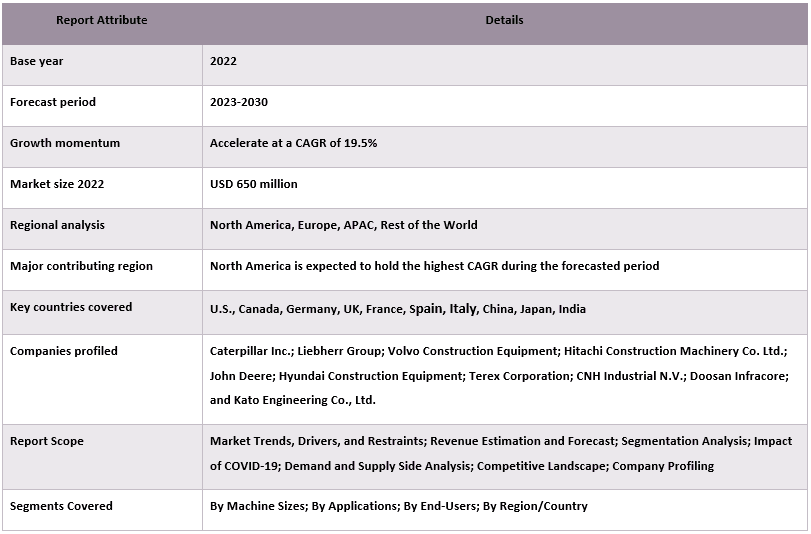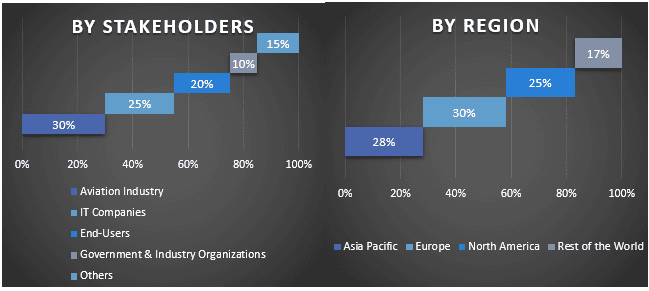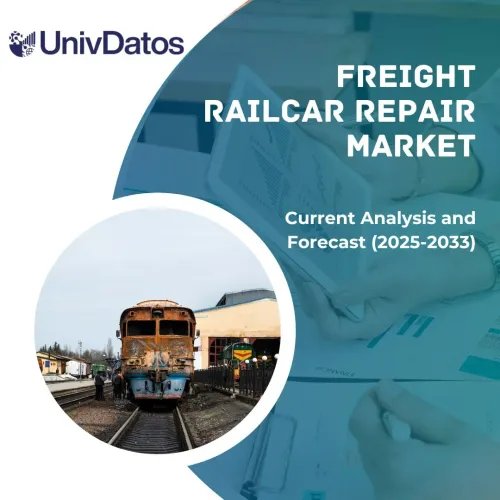- Home
- About Us
- Industry
- Services
- Reading
- Contact Us
Electrical Wheel Loader Market: Current Analysis and Forecast (2023-2030)
Emphasis on Machine Sizes (compact loaders, and medium & large loaders); Applications (material handling, loading & unloading, snow removal, and others); End-Users (construction, mining &quarrying, agriculture & landscape, waste management and recycling, and others); and Region/Country

The Electrical Wheel Loader Market was valued at USD 650 million in 2022 and is expected to grow at a steady rate of around 19.5% in the forecasted period (2023-2030) owing to the advancements in electric vehicle technology. An electric wheel loader is a type of heavy-duty construction equipment that is powered by an electric motor instead of a traditional internal combustion engine. Electric wheel loaders produce zero emissions and are much quieter than traditional diesel-powered wheel loaders, making them a safer and healthier option for workers on the job site. Various government regulations are aimed at reducing greenhouse gas emissions which is further fueling the growth of the market. For instance, in the United States, the Environmental Protection Agency (EPA) has established emissions standards for heavy-duty vehicles, including wheel loaders. These standards require manufacturers to reduce emissions of pollutants such as nitrogen oxides and particulate matter. Electrical wheel loaders, which produce zero emissions, are well-suited to meet these standards, making them a popular choice for companies looking to comply with regulations.
Some of the major players operating in the market include Caterpillar Inc.; Liebherr Group; Volvo Construction Equipment; Hitachi Construction Machinery Co. Ltd.; John Deere; Hyundai Construction Equipment; Terex Corporation; CNH Industrial N.V.; Doosan Infracore; and Kato Engineering Co., Ltd.
Insights Presented in the Report
“Amongst machine sizes, compact loaders category to witness significant market growth during the forecast period.”
Based on the machine sizes, the market is segmented into compact loaders and medium & large loaders. Among these, the compact loaders segment is leading the maximum share of the market as they are well-suited to a wide range of applications, including construction, landscaping, and material handling. They are smaller and more maneuverable than larger loaders, making them easier to use in tight spaces and on uneven terrain. This makes them popular with companies and individuals who need a versatile and efficient machine for a variety of tasks.
“Amongst applications, material handling category to witness significant market growth during the forecast period.”
Based on applications, the market is segmented into material handling, loading & unloading, snow removal, and others. Among them, the material handling segment is likely to have a significant impact on the market. As it is a key application for wheel loaders, electrical versions of these machines offer several advantages over traditional diesel-powered machines. For example, they produce zero emissions, making them more environmentally friendly and compliant with regulations in many regions. They are also generally more energy-efficient, which can reduce operating costs for companies.
“North America to hold a significant share in the market.”
North America is anticipated to hold a large share of the market. The market for electrical wheel loaders in North America is driven by a strong construction industry and growing demand for efficient and environmentally friendly construction equipment. Stricter environmental regulations and an increased emphasis on sustainability have prompted the construction and heavy equipment industries in the region to seek greener alternatives. This aligns with a global trend toward reducing emissions and carbon footprints. Additionally, advancements in battery technology have significantly improved the feasibility and performance of electric wheel loaders, making them a competitive choice. For instance, the Caterpillar 9T Electric an electrical wheel loader was launched by Caterpillar in 2021 and is designed for use in a variety of applications, including construction, mining, and waste management. It has a rated operating capacity of 9,094 pounds (4,134 kg) and is powered by a 66-kWh lithium-ion battery pack.
Electrical Wheel Loader Market Report Coverage

Reasons to buy this report:
- The study includes market sizing and forecasting analysis validated by authenticated key industry experts.
- The report presents a quick review of overall industry performance at one glance.
- The report covers an in-depth analysis of prominent industry peers with a primary focus on key business financials, product portfolio, expansion strategies, and recent developments.
- Detailed examination of drivers, restraints, key trends, and opportunities prevailing in the industry.
- The study comprehensively covers the market across different segments.
- Deep dive regional level analysis of the industry.
Customization Options:
The global Electrical Wheel Loader market can further be customized as per the requirement or any other market segment. Besides this, UMI understands that you may have your own business needs, hence feel free to connect with us to get a report that completely suits your requirements.
Table of Content
Research Methodology for the Electrical Wheel Loader Market Analysis (2023-2030)
Analyzing the historical market, estimating the current market, and forecasting the future market of the global Electrical Wheel Loader market were the three major steps undertaken to create and analyze the adoption of Electrical Wheel Loader in major regions globally. Exhaustive secondary research was conducted to collect the historical market numbers and estimate the current market size. Secondly, to validate these insights, numerous findings and assumptions were taken into consideration. Moreover, exhaustive primary interviews were also conducted, with industry experts across the value chain of the global Electrical Wheel Loader market. Post assumption and validation of market numbers through primary interviews, we employed a top-down/bottom-up approach to forecasting the complete market size. Thereafter, market breakdown and data triangulation methods were adopted to estimate and analyze the market size of segments and sub-segments of the industry pertains to. Detailed methodology is explained below:
Analysis of Historical Market Size
Step 1: In-Depth Study of Secondary Sources:
Detail secondary study was conducted to obtain the historical market size of the Electrical Wheel Loader market through company internal sources such as annual reports & financial statements, performance presentations, press releases, etc., and external sources including journals, news & articles, government publications, competitor publications, sector reports, third-party database, and other credible publications.
Step 2: Market Segmentation:
After obtaining the historical market size of the Electrical Wheel Loader market, we conducted a detailed secondary analysis to gather historical market insights and share for different segments & sub-segments for major regions. Major segments are included in the report as machine sizes, applications and end-users. Further country-level analyses were conducted to evaluate the overall adoption of testing models in that region.
Step 3: Factor Analysis:
After acquiring the historical market size of different segments and sub-segments, we conducted a detailed factor analysis to estimate the current market size of the Electrical Wheel Loader market. Further, we conducted factor analysis using dependent and independent variables such as various machine sizes, applications and end-users of Aircraft Actuator. A thorough analysis was conducted for demand and supply-side scenarios considering top partnerships, mergers and acquisitions, business expansion, and product launches in the Electrical Wheel Loader market sector across the globe.
Current Market Size Estimate & Forecast
Current Market Sizing: Based on actionable insights from the above 3 steps, we arrived at the current market size, key players in the global Electrical Wheel Loader market, and market shares of the segments. All the required percentage shares split, and market breakdowns were determined using the above-mentioned secondary approach and were verified through primary interviews.
Estimation & Forecasting: For market estimation and forecast, weights were assigned to different factors including drivers & trends, restraints, and opportunities available for the stakeholders. After analyzing these factors, relevant forecasting techniques i.e., the top-down/bottom-up approach were applied to arrive at the market forecast for 2030 for different segments and sub-segments across the major markets globally. The research methodology adopted to estimate the market size encompasses:
- The industry’s market size, in terms of revenue (USD) and the adoption rate of the Electrical Wheel Loader market across the major markets domestically
- All percentage shares, splits, and breakdowns of market segments and sub-segments
- Key players in the global Electrical Wheel Loader market in terms of products offered. Also, the growth strategies adopted by these players to compete in the fast-growing market
Market Size and Share Validation
Primary Research: In-depth interviews were conducted with the Key Opinion Leaders (KOLs) including Top Level Executives (CXO/VPs, Sales Head, Marketing Head, Operational Head, Regional Head, Country Head, etc.) across major regions. Primary research findings were then summarized, and statistical analysis was performed to prove the stated hypothesis. Inputs from primary research were consolidated with secondary findings, hence turning information into actionable insights.
Split of Primary Participants in Different Regions

Market Engineering
The data triangulation technique was employed to complete the overall market estimation and to arrive at precise statistical numbers for each segment and sub-segment of the global Electrical Wheel Loader market. Data was split into several segments & sub-segments post studying various parameters and trends in the areas of machine sizes, applications and end-users in the global Electrical Wheel Loader market.
The main objective of the Global Electrical Wheel Loader Market Study
The current & future market trends of the global Electrical Wheel Loader market were pinpointed in the study. Investors can gain strategic insights to base their discretion for investments on the qualitative and quantitative analysis performed in the study. Current and future market trends determined the overall attractiveness of the market at a regional level, providing a platform for the industrial participant to exploit the untapped market to benefit from a first-mover advantage. Other quantitative goals of the studies include:
- Analyze the current and forecast market size of the Electrical Wheel Loader market in terms of value (USD). Also, analyze the current and forecast market size of different segments and sub-segments
- Segments in the study include areas of machine sizes, applications and end-users.
- Define and analysis of the regulatory framework for the Electrical Wheel Loader industry.
- Analyze the value chain involved with the presence of various intermediaries, along with analyzing customer and competitor behaviors of the industry.
- Analyze the current and forecast market size of the Electrical Wheel Loader market for the major region.
- Major countries of regions studied in the report include Asia Pacific, Europe, North America, and the Rest of the World.
- Company profiles of the Electrical Wheel Loader market and the growth strategies adopted by the market players to sustain in the fast-growing market.
- Deep dive regional level analysis of the industry
Related Reports
Customers who bought this item also bought










